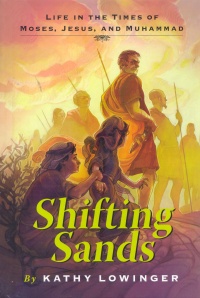| ________________
CM . . .
. Volume XX Number 30. . . .April 4, 2014
excerpt:
In this work of fiction, Kathy Lowinger lets readers glimpse the central figures of the Abrahamic religions at pivotal points in their missions on earth. She does so by showing each through the eyes of a young teenager. Each story is about losing one's community and becoming part of a community again. The first story centres on 14-year-old Dina, a Hebrew slave and a weaver at the Pharaoh's palace in Egypt around 1320 B.C.E.. The queen wants her to accompany her and her household to an oasis. Dina recognizes the honour and opportunity, but her extended family lives near Goshen, and she fears that she may never see them again. During the Salt Festival, she takes advantage of the confusion to slip back home where she learns from her grandfather that Moses, the great Hebrew leader, has come back from exile to tell the Pharaoh to "Let my people go." When the Pharaoh refuses to release the Hebrews from slavery, plagues are visited upon the Egyptians. Finally, during the plagues of 24 hour darkness and deaths of firstborn sons, Pharaoh agrees, and Moses and Aaron rally the Hebrews to follow them into the unknown. After briefly hesitating, Dina goes too. Author Lowinger next provides a paragraph summarizing the rest of the story. Readers then leap about 1350 years into the future to the story of Mattan who lives in Judea around 33 C.E. Mattan, a shepherd youth living under the brutal Roman occupation, feels trapped in poverty and hopelessness. When he decides to leave home to seek a better fortune, his parents worry that he will join a rebel band. As Mattan tries to make his way, new instances of Roman oppression galvanize him. Eventually, as part of a travelling magician's show, he meets (the Apostle) Peter, who tells him of Jesus's miracles and teaching. Eventually, Mattan joins Jesus' followers and travels with them. Jesus's life and work have been interpreted in many different ways, but here the emphasis is on the incompatibility of his values with those of Rome. The story pauses after Jesus's arrest. The crucifixion is mentioned, not presented; the story ends with Mattan back in his village with a changed perspective, convinced that "we are all important in God's eyes." A short epilogue explains the spread of Christianity. The next story takes readers about 650 years into the future, to 622 C.E., in Arabia, and Fallah. A band of tribesmen, including Fallah's father, went camel-raiding and killed a member of another tribe. Fallah's mother urges him and his brother to leave home to escape death in the inevitable blood feud. Without the tribe, they feel "nameless, as puny as single grains of sand in the desert." In the desert, they come upon a caravan and are given food. They accompany the caravan to Mecca where they see the Kaaba and meet a poet reciting in the market place. The poet hires them as his reciters. When they notice a man in a simple robe being taunted, the poet explains that he is Muhammad, and the poet fills them in on Muhammad’s background, most notably the miracle in a mountain cave which gave him the words of Allah. Muhammad's revelations from Allah have angered the corrupt tribe that runs Mecca. Fallah joins Muhammad's followers, suffers various tribulations, and eventually rises to become a "companion" among Muhammad's followers. When Muhammad escapes murderers in Mecca, the brothers head for Medina to "take their place in the family of believers." The epilogue, which tells about Muhammad's subsequent bloodless capture of Mecca is a dramatic and entertaining story even when presented as summary. Reading all three stories, I felt that I was being denied the most exciting parts. Possibly the author decided not to present "on stage" the dramatic episodes that preceded and followed the time frame of her stories in the belief that they are already well-known and much recounted. As a child, I always found "Bible stories" interesting and sometimes exciting. Knowing them has helped me understand Biblical references in English literature. When young, I sometimes found the stories puzzling and in need of historical context. Lowinger's sub-title, Life in the Times of Moses, Jesus and Muhammad made me think, at first, that her book was a nonfiction work providing historical context for young readers of today. Of course, in presenting her fictional characters in unique settings, Lowinger does provide some historical and sociological background. Shifting Sands includes useful notes about Judaism, Christianity and Islam, and other topics, along with colourful maps and three large illustrations. Kathy Lowinger's sources of information sources included a rabbi, an Egyptologist, the President of the Council for Muslims Facing Tomorrow, a specialist in bedouin poetry, and the editor-in-chief of the Pontifical Institute for Mediaeval Studies. Shifting Sands is a worthy book which may inspire greater respect and understanding among children of different faith backgrounds. Recommended. Ruth Latta's most recent book is the teen novel The Songcatcher and Me.
To comment
on this title or this review, send mail to cm@umanitoba.ca.
Copyright © the Manitoba Library Association. Reproduction for personal
use is permitted only if this copyright notice is maintained. Any
other reproduction is prohibited without permission.
NEXT REVIEW |
TABLE OF CONTENTS FOR THIS ISSUE
- April 4, 2014.
AUTHORS |
TITLES |
MEDIA REVIEWS |
PROFILES |
BACK ISSUES |
SEARCH |
CMARCHIVE |
HOME |
